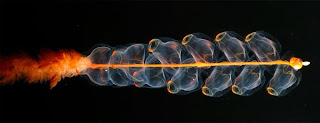
Blood-Red Jellyfish
Photograph by Kevin Raskoff
--Christine Dell'Amore
December 11, 2009--In the black depths of the frigid Arctic Ocean, scientists on a 2005 expedition found a splash of color: The brilliant, blood-red Crossota norvegica jellyfish (pictured).
The creature was spotted by a remotely operated vehicle 8,530 feet (2,600 meters) underwater during a two-month National Oceanic and Atmospheric Administration (NOAA) expedition to the Canada Basin, the deepest and least explored part of the Arctic waters.
Though C. norvegica is not a new species, several new deep-sea animals were discovered during the expedition--some of which were announced in recent research papers in 2009.
Biologist and team member Kevin Raskoff, of Monterey Peninsula College in California, was surprised at the diversity of jellyfish living in the extreme polar seas.
"We knew there were going to be interesting jellies up there," Raskoff said by email, "but the reality surpassed all of our imaginations!"

"Sea Angel"
Photograph by Kevin Raskoff
Biologists captured a so-called sea angel, Clione limacina (pictured), at about 1,148 feet (350 meters) during a 2005 research expedition to the Arctic Ocean.
This little angel apparently doesn't mind showing a little skin: It's actually a naked snail without a shell, scientists said in December 2009.
Such marine snails--most of them the sizes of lentils--are widely eaten by many species, making them the "potato chip" of the oceans, biologist Gretchen Hofmann, of the University of California, said in a 2008 statement.

New Narcomedusa Jellyfish
Photograph by Kevin Raskoff
A new genus and species of narcomedusa--a group of common jellyfish--was discovered from one specimen in 2002 and by the hundreds in 2005 (pictured, an individual spotted in 2005), a scientist said in December 2009.
That scientists could discover a new genus of such a well-known jellyfish group highlights how little we know about the Arctic, Monterey Peninsula College's Raskoff said by email.
Jellies are among the least understood groups of animals on Earth, Raskoff added. "They seem about as alien as animals get."

Siphonophore Colony
Photograph by Kevin Raskoff
Each siphonophore, such as the one seen above in 2005, is actually a colony of creatures related to jellyfish—such as the nectophores, or swimming bells, on the right half above, which provide propulsion for the colony. The members of the colony share a tubular stem (shown in orange), which delivers nutrients.
Reaching 10 feet (3.1 meters) in length, some siphonophores are among the largest animals in the deep sea, Monterey Peninsula College's Raskoff said in December 2009.

Red-and-Purple Jellyfish
Photograph by Kevin Raskoff
This red-and-purple Crossota millsae, collected deep in the Arctic Ocean in 2005, is also found off of California and Hawaii, a scientist said in December 2009.
Biologists are realizing that jellyfish are more common predators in the oceans than thought, Monterey Peninsula College's Raskoff said by email.
"They are a very underappreciated and understudied group that have big roles to play in the food webs of the deep sea."

Arctic Jellyfish
Photograph by Kevin Raskoff
Sminthea arctica (pictured in 2005) is the most common jellyfish found in the Arctic Ocean, a scientist said in December 2009.
Scientists plan to research more of the unexplored Arctic waters before warming and ice melt drastically transforms the ocean environment, according to NOAA's Web site.



















